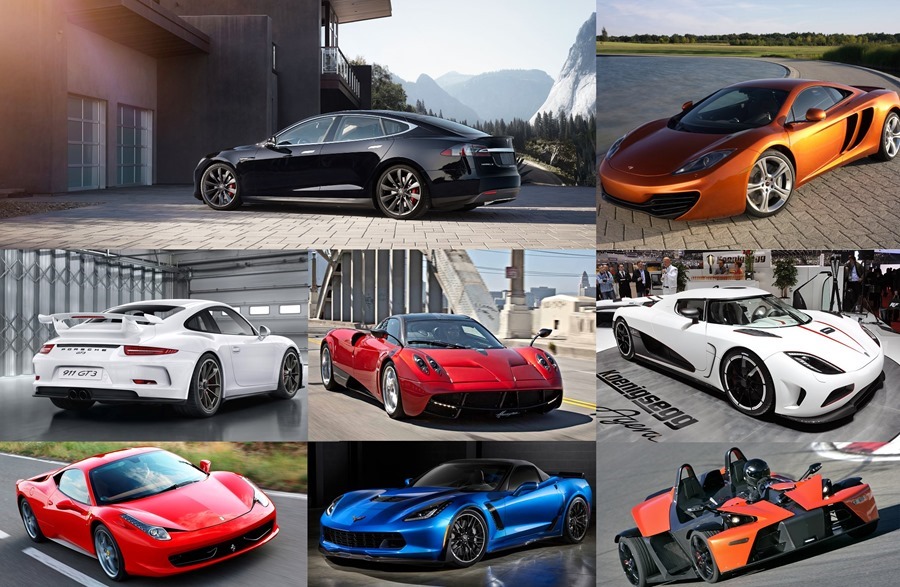

Overnight, Tesla announced some important changes to their lineup. A new upgrade option for the Model S will introduce a ‘ludicrous’ mode that delivers an upgrade in performance. If the all-electric power wasn’t enough before, it can now propel drivers from 0-60mph (96km/h) in just 2.8 seconds. This extra performance certainly makes it the fastest electric production vehicle on the planet, but the Model S is now faster than many of the worlds supercars.
This list on Wikipedia lists the quickest production road cars ever made. The top title goes to the 2.2 second Porsche 918 Spyder and the stunning Ferrari LaFerrari does it in a cool 2.4 seconds. The big difference is of course the price. Many of the challengers cost between 3 and 10 times the price of the model S and because the model S is a mass production car, it’s likely Tesla will sell more than most of the faster vehicles combined.
The software update will cost $10,000, so it won’t be for everyone, but compared to the price of the faster cars, it’s a bargain. The increased speed will mean drivers (and passengers) will enjoy 1.1 geforces under acceleration.
When you stop and think for a second just how fast the Tesla Model S is, it’s kind of ridiculous that under your right foot could be basically the power of a rollercoaster, available at any red light. Thanks to some smart electronics, the power delivery means you get to use that power, instead of turning those expensive tyres into clouds of smoke. The Superman rollercoaster at Movie World theme park on the gold coast, accelerates from 0-100km/h in 2 seconds, wait another .8 of a second and your Tesla would match it (and keep going).
If you live your life a quarter mile at a time, it’s time to think electric. The Model S with the Luuudicrous Mode can account for the quarter mile in just 10.9 seconds.. right from the factory. The time to 155 mph (249km/h) is also improved by a massive 20%. Not particularly useful on the speed limited roads, but if you find yourself on a track, give it a bash.
While working on our goal of making the power train last a million miles, we came up with the idea for an advanced smart fuse for the battery. Instead of a standard fuse that just melts past a certain amperage, requiring a big gap between the normal operating current and max current, we developed a fuse with its own electronics and a tiny lithium-ion battery. It constantly monitors current at the millisecond level and is pyro-actuated to cut power with extreme precision and certainty.
That was combined with upgrading the main pack contactor to use inconel (a high temperature space-grade superalloy) instead of steel, so that it remains springy under the heat of heavy current. The net result is that we can safely increase the max pack output from 1300 to 1500 Amps.
There was also two other announcements this morning from Tesla, a cheaper entry level model, and a new upgrade option for increased range, with a 90kWh battery pack.
70 kWh for $70k
Now, on to the awesome news of today. The 70 kWh version of the Model S in the single motor version at $70k costs $5k less than the dual motor version, consistent with the price differential for the single and dual motor 85 kWh car. Importantly, enough options are now standard that you will have bought a great car even if you pick the base version.
In many countries, national and state/province purchase incentives for clean energy vehicles improve the price to some degree. In the US, for example, the price after incentives is usually around $60k. Also, not having to buy gasoline and needing less service for an electric car typically saves around $2k per year, which accumulates to $10k over the national average car ownership period of five years. This economic advantage is often overlooked when evaluating gasoline vs electric cars. Moreover, these savings are experienced immediately in your monthly cost of transportation if you lease or finance an electric car.
90 kWh Pack
New buyers now have the option of upgrading the pack energy from 85 to 90 kWh for $3k, which provides about 6% increased range. For example, this takes our current longest range model, the 85D, to almost 300 miles of highway range at 65mph.
Existing owners can also purchase the pack upgrade, but I wouldn’t recommend doing so unless usage is on the edge of current range. On average, we expect to increase pack capacity by roughly 5% per year. Better to wait until you have more time on your existing pack and there is a larger accumulated pack energy difference.
You can read more about today’s announcements at Tesla’s blog.
